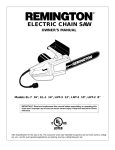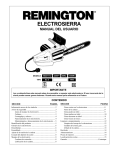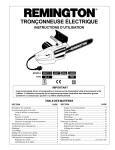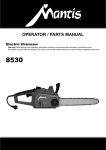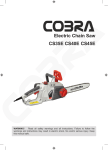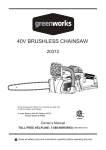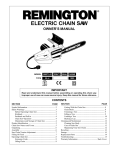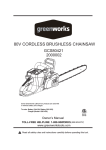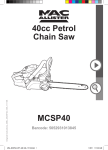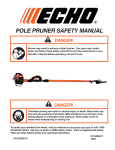Download Remington Power Tools EL-3 User's Manual
Transcript
® ELECTRIC CHAIN SAW OWNER’S MANUAL ® Model EL-3 IMPORTANT Read and understand this manual before assembling or operating this chain saw. Improper use of saw can cause severe injury. Keep this manual for future reference. ® ELECTRIC CHAIN SAW SAFETY WARNINGS Do not assemble or handle guide bar or saw chain while connected to a power source. 1. 2. 3. 4. 5. 6. 7. 8. 9. 10. 11. 12. 13. 14. Keep the work area clean. Cluttered areas invite accidents. Do not let the chain saw get wet. Don’t use the chain saw in the rain or in damp or wet locations. Keep the work area well lit. Keep bystanders and animals out of the work area. Store the chain saw in a safe place, out of the reach of children. Don’t force the chain saw. Only make cuts within the capacity of your chain saw. Wear proper apparel: safety footwear, snug fitting clothing, safety glasses, head and hearing protection. Rubber gloves and footwear are recommended when working outdoors. Never carry the chain saw by its cord. Never yank the cord to disconnect the plug. Keep the cord away from heat, oil and sharp edges. Secure your work by use of clamps or chocks, freeing both hands to hold the chain saw. Don’t overreach. Keep proper footing and balance at all times. Always disconnect the cord when the chain saw is not in use, when moving from one location to another and before servicing. Keep the chain saw clean. Never operate a chain saw that is damaged, improperly adjusted or not completely assembled. Keep the saw handles dry, clean and free of oil. Keep the saw chain properly tensioned and the saw chain cutters properly sharpened. Follow the lubricating instructions. Avoid having loose or missing parts. Keep all the fasteners tight. Remove all tools before touching the switch trigger. 15. Never place your finger near the switch trigger until you are ready to make a cut. 16. Keep all parts of your body away from the moving saw chain. Always carry the chain saw with the motor stopped and the guide bar and saw chain to the rear. 17. Never operate the chain saw when you are fatigued. 18. Guard against kickback by following the explanation in this manual. 19. Use extreme caution when cutting small branches. Watch for limbs under tension. 20. Use only extension cords suitable for outdoor use and appropriately marked. 21. When replacing parts use only identical replacement parts. IMPORTANT: Do not use any other attachments or accessories except those noted in this manual. IMPORTANT: Save these instructions for future use. 2 101755 OWNER’S MANUAL CHAIN SAW NAMES AND TERMS Notching Undercut A notch cut in a tree that directs the tree’s fall. Boring The process involved in cutting bar and saw chain. with the saw chain at the nose (tip) of the guide bar, in order to make a hole. This is not recommended because of hazard of kickback. Rear Handle The support handle located at Bucking The process of cross cutting a felled tree or log into lengths. A chain saw without the saw chain and guide bar. Chain Saw Powerhead Clutch A mechanism for connecting and disconnecting a driven member to and from a rotating source of power. Drive Sprocket or Sprocket The toothed part that drives the saw chain. Felling The process of cutting down a tree. Felling Back Cut The final cut in a tree Oiler Control A system for oiling the guide or toward the rear of the saw. Reduced Kickback Guide Bar A guide bar which has been demonstrated to reduce kickback significantly. Saw Chain A loop of chain having cutting teeth, that cut the wood, and that is driven by the motor and is supported by the guide bar. Spiked Bumper (Spike) The pointed tooth or teeth for use when felling or bucking to pivot the saw and maintain position while sawing. Switch A device that when operated will complete or interrupt an electrical power circuit to the motor of the chain saw. felling operation made on the opposite side of the tree from the notching undercut. Switch Linkage The mechanism that trans- Front Handle The support handle located Switch Lockout A movable stop that prevents the unintentional operation of the switch until manually actuated. at or toward the front of the chain saw. Front Handle Guard A structural barrier mits motion from a trigger to the switch. between the front handle of a chain saw and the guide bar, typically located close to the hand position on the front handle. Guide Bar A solid railed structure that supports and guides the saw chain. Kickback The backward and/or upward motion of the guide bar occurring when the saw chain near the nose of the top area of the guide bar contacts any object such as another log or branch, or when the wood closes in and pinches the saw chain in the cut. Kickback, Pinch The rapid pushback of the saw which can occur when the wood closes in and pinches the moving saw chain in the cut along the top of the guide bar. Kickback, Rotational The rapid upward and backward motion of the saw which can occur when the moving saw chain near the upper portion of the tip of the guide bar contacts an object, such as a log or branch. Normal Cutting Position Those posi- tions assumed in performing the bucking and felling cuts. 101755 3 ® ELECTRIC CHAIN SAW ASSEMBLY INSTRUCTIONS 1. H ASSEMBLING GUIDE BAR, SAW CHAIN AND HAND GUARD IMPORTANT: Do not clamp in a vise or abuse during assembly. Always wear gloves when handling the saw chain. Remove two (2) guide bar nuts (D), two (2) guide bar bolts (E) and one (1) Phillips screw (N) from the plastic bag. 2. Lay the saw chain (C) out flat. 3. Install hand guard (K) by press fitting the two bosses (L) into the hex shaped holes in the saw body. Install the Phillips screw (N) into the hand guard and saw handle and tighten securely. 4. Turn adjusting screw (A) counterclockwise to move the adjusting block (B) as far as it will go to the rear of the mount (See Figure 1). 5. Slide the guide bar (G) on to the adjusting plate (H) aligning adjusting block (B) with the square adjusting hole (I) in the guide bar. 6. Rotate the sprocket support (F) back over the guide bar so the holes line up. 7. Insert ONLY the front guide bar bolt (E) through the body of the saw and through sprocket support (F). Tighten the nut (D) only finger tight. This will allow clearance for the installation of the saw chain. 8. Slide the saw chain between the side cover and the sprocket (J), in the top groove of the guide bar (G) and around the guide bar nose. 9. Insert remaining guide bar bolt (E) and install nut (D) finger tight. 10. Adjust the saw chain tension by following the tension adjustment instructions. 2. B A 3. 4. Figure 1 - Part Locations For Assembling Guide Bar 1. CAUTION: If saw chain is assembled backwards, the saw will vibrate excessively and will not cut. N 5. K C E 6. L J I G Before adjusting the saw chain, make sure the guide bar nuts (D) are only finger tight (See Figure 1 and 2). Turn adjusting screw (A) clockwise until all slack is out of the saw chain. Wear protective gloves and pull the saw chain (C) around the guide bar. It should move freely. If necessary, readjust chain using adjusting screw (A). There should be no gap between the side links of the saw chain and the bottom of the guide bar (See Figure 3). Tighten guide bar nuts (D) using a wrench. Nuts not tightened securely will allow guide bar movement resulting in loose chain and increasing the possibility of kickback and damage to mating parts. A new chain will stretch and should be checked after the first few minutes of operation. Disconnect saw from power source. Adjust the chain tension after it has had a few minutes to cool down. Use protective gloves to protect hands from chain teeth. D F Figure 2 - Assembling Guide Bar, Chain, and Hand Guard Cutting Edges Forward Guide Bar SAW CHAIN TENSION ADJUSTMENT CAUTION: The saw chain tension must be properly maintained. Failure to do so will cause rapid saw chain, guide bar and sprocket wear. A loose chain will increase the possibility of kickback and may jump out of the guide bar groove. This may cause damage to the chain and injury to the operator. Tighten guide bar nuts securely. 4 Standard Chain Correct Saw Chain Tension Guide Bar Incorrect Saw Chain Tension Gap Guide Bar Figure 3 - Saw Chain Adjustment 101755 OWNER’S MANUAL OPERATING INSTRUCTIONS FILLING OIL RESERVOIR 1. 2. 3. 4. Remove the oil fill knob. Fill the oil reservoir with SAE #30 motor oil. Replace and tighten fill knob IMMEDIATELY . This will avoid continuous oil feed. Wipe off excess oil. Note: When cutting in temperatures below 30°F, use SAE #10 oil. In temperatures above 75°F, use SAE #40 oil. EXTENSION CORDS Switch Lockout The moveable button that prevents unintentional operation of the trigger. The trigger cannot be depressed to start the saw again until the lockout is pushed in. When the trigger is released the lockout will automatically lock the trigger in the power off position. Guard The restraint in front of the handle which prevents accidental contact of the hand with the chain. Oil Fill Knob By pushing the oil fill knob, using only moderate pressure, oil will feed on the guide bar and saw chain. To keep the saw chain oiled, push the oil fill knob at least once before each cut. Frequently check the oil sight level hole located on the front left side of the chain saw. Guard The proper extension cord must be used with the chain saw. Use a HO7RN extension cord no less than 1.5 square millimeters at distances up to 30 meters. It is recommended that a ground fault circuit interrupter be part of the power supply system. Use an extension cord heavy enough to carry the current your saw will draw. An undersized cord will cause a voltage drop at the saw, loss of power and overheating. Rear Switch Handle Lockout LEFT SIDE Switch Trigger Guide Bar Front Handle WARNING: Read and understand all instructions before operating the saw. Manual Oil Control RIGHT SIDE Power Cord Sprocket the rear of the saw, houses the control trigger. A firm grip of this handle while cutting is necessary to control the chain saw in the cut. Trigger Switch The control which starts and stops the motor. The motor only operates at full speed. 101755 A properly installed Front Hand Guard can help reduce injuries from kickback. Install by following the assembly instructions in this manual. DO NOT remove or replace it with a substitute. Causes of Kickback Kickback occurs when a chain cutter going around the upper quadrant of the guide bar nose is suddenly stopped (See Figure 5). This can happen when the cutter contacts a solid object or is pinched. The result is a sudden reverse action which kicks the saw tip up and/or back toward the operator. Kickback may also occur when a chain cutter is pinched along the length of the bar. The result is a sudden linear reverse action which kicks the saw straight back at the operator. Saw Chain Front Handle The support located toward Rear Handle The support located toward Your saw is equipped with a low-kickback saw chain and a reduced kickback guide bar. Both devices reduce the possibility of rotational kickback which can occur when the tip of the bar contacts a solid object. DO NOT assume that kickback will not happen because of these devices. Contact of the guide bar tip with any object should be avoided. DIRECTION SAW CONTROLS the front of the chain saw which extends from the left side of the chain saw. The proper grip of this handle in the normal cutting position gives you the greatest ability to control the chain saw in the cut (See Figure 4). Kickback Safety Devices On Your Saw Sprocket Guard Sprocket Support CONTACT HERE 90 DEGREE QUADRANT Figure 4 - Left and Right Sides KICKBACK WARNING: Guard against kickback. Study this section before operating saw. Kickback is the sudden upward and/or backward movement of the chain saw while cutting. If the chain saw moves toward the operator in an uncontrolled manner, serious or fatal injuries may result. Understanding why kickback occurs can help you reduce the chance of kickback and maintain control. 5 Figure 5 - Causes of Kickback ® ELECTRIC CHAIN SAW OPERATING INSTRUCTIONS CUTTING WITH THE CHAIN SAW Continued Examples of Kickback Cutting with your electric chain saw can be made easier and safer if you will follow these simplified instructions. Before trying to cut with the chain saw be sure to: 1. Read all the safety precautions on the front cover. 2. Support the log to be cut off the ground so the saw chain does not touch the ground as it cuts through the wood. 3. Keep the nose of the guide bar from contacting a log, branch, the ground or any other obstruction. 4. DO NOT overreach. 5. Stand with your weight evenly distributed on both feet and slightly to the left side of the saw. This keeps your body from being in a direct line with the cutting chain (see figure 7). With the saw in operation, kickback occurs when: • The chain at the guide bar nose touches any solid object. • Incorrectly starting a boring cut. • A cutter on guide bar nose strikes the bottom of the saw cut while the guide bar is being reinserted in the cut (See Figure 6). • The chain is pinched in the cut. Figure 6 - Examples of Kickback To Help Reduce the Chance of Kickback 1. 2. 3. 4. 5. 6. Hold the chain saw firmly with both hands with thumbs and fingers encircling the handles. Always be attentive to what you are doing, be alert for shifting of the log or other conditions which will cause a pinch. Always know where the nose of the guide bar is. DO NOT let the guide bar nose contact any object (See Figure 6). Never use a dull or loose chain. Always use a correctly sharpened, properly tensioned chain. Use your saw within its capacity. DO NOT bury the nose (See Figure 6). Figure 7 - The Correct Stance 7. 8. 9. When ready to make a cut, push in the lockout button and squeeze the trigger switch. Start the chain saw above the log. Always bring the saw up to speed before letting the chain touch the wood. When starting a cut, be alert to possible bouncing or skating (sideward movement) of the saw. Place the saw against the wood and guide it using a light pressure. 10. DO NOT FORCE THE SAW SO THAT THE CHAIN SPEED IS GREATLY REDUCED. THIS WILL OVERLOAD THE MOTOR AND CAN CAUSE MOTOR BURN OUT. 11. Stop the saw by releasing the trigger switch. Make sure the chain has come to a complete stop before setting the saw down. 12. If you have never used a chain saw before, in addition to reading and understanding the operating instructions, you should seek informed practical instruction from your chain saw dealer or other knowledgeable individuals. As a minimum, you should practice cutting logs on a sawhorse or cradle until you are able to maintain a steady even cutting rate before attempting to cut limbs from a tree. TRIMMING A TREE MAINTAIN SAFETY SYSTEM. Normal Wear On Saw and its Effects On Kickback Safety Follow the maintenance instructions in this manual on cleaning the saw, proper storage, chain and guide bar maintenance. Regular inspection and a good maintenance program will increase the service life of your saw. Even with proper sharpening, kickback potential can increase with each filing. Figure 9 - Operate With Both Hands Figure 8 - Do Not Operate With One Hand 6. DO NOT OPERATE WITH ONE HAND (See Figure 8). Use a firm grip with thumbs and fingers encircling both handles as shown in Figure 9. 6 WARNING: DO NOT OPERATE your chain saw while IN A TREE, ON A LADDER, ON ANY OTHER UNSTABLE SURFACE or IN ANY AWKWARD POSITION which might cause you to loose control of the chain saw. DO NOT cut limbs higher than your shoulder. Note: When conditions are encountered which are beyond your experience or capacity seek professional help. 101755 OWNER’S MANUAL Cutting a Limb 1. 2. 3. 4. 1. Make the first cut from the underside about 1/2 foot from the trunk and 1/3 through the diameter of the limb (See Figure 10). Make the second cut two to four inches farther out on the limb from above until the limb falls. Make the third cut 1/3 the diameter of the limb stub from underneath as close to the trunk as possible. Make the fourth cut from above as close to the trunk as possible to meet the third cut. 4th Final Stub Cut 2nd Limbing Cut (to avoid pinching) 2. 3. 4. 5. 6" (15cm) 2" to 4" (5-10 cm) 1st Limbing Undercut (to avoid splintering) 3rd Stub Undercut (to avoid splintering) Figure 10 - Cutting A Limb The chain saw operator should keep on the uphill side of the terrain as the tree is likely to roll or slide downhill after it is felled. CONSIDER the natural lean of the tree, the location of larger branches and the wind direction to judge which way the tree will fall. A RETREAT PATH should be planned and cleared as necessary before cuts are started. The retreat path should extend back and diagonally to the rear of the expected line of fall as illustrated in Figure 11. CLEAR the work area around the tree to be cut and on your retreat path. REMOVE dirt, stones, loose bark, nails, staples, and wire from the tree where felling cuts are to be made. CAUTION: When bucking and felling operations are being performed by two or more persons at the same time, the felling operation should be separated from the bucking operation by a distance of at least twice the height of the tree being felled. Trees should not be felled in a manner that would endanger any person, strike any utility line or cause any property damage. If the tree does make contact with any utility line, the utility company should be notified immediately. 5. As the felling cut gets close to the hinge, the tree should begin to fall. If there is any chance that the tree may not fall in the desired direction or it may rock back and bind the saw chain, stop cutting before the felling back cut is complete and use wedges of wood, plastic or aluminum to open the cut and drop the tree along the desired line of fall. When the tree begins to fall remove the chain saw from the cut, stop the motor, put the chain saw down, then use the retreat path planned. Be alert for overhead limbs falling and watch our footing. Direction of Fall 3rd Felling Cut Hinge Approx. 2" (5 cm) Retreat Path Direction of Fall 1st - Lower Notching Cut LIMBING Figure 11 - Retreat Path From Tree FELLING TECHNIQUES 1. 2. 3. Make the first lower notching cut 1/3 the diameter of the tree and perpendicular to the line of fall. This will help to avoid pinching of either the saw chain or the guide bar when the second notching cut is made (See Figure 12). Make the second upper notching cut at an angle to meet the first notching cut at 1/3 the diameter of the tree. Make the felling back cut at least 2 inches higher than the horizontal notching cut as illustrated in Figure 12. Keep the felling back cut parallel to the horizontal notching cut. Make the felling back cut so enough wood is left to act as a hinge. The hinge wood keeps the tree from twisting and falling in the wrong direction. DO NOT cut through the hinge. Limbing is removing the branches from a fallen tree. When limbing, leave larger lower limbs to support the log off the ground. Remove the small limbs in one cut as illustrated in Figure 13. Branches under tension should be cut from the bottom up to avoid binding the chain saw. Keep work off ground. Leave support limbs until log is cut. Figure 13 - Limbing A Tree 101755 2nd - Upper Notching Cut Figure 12 - Felling A Tree 45° FELLING A TREE WARNING: Felling a tree should not be undertaken unless the person has extensive experience or obtains professional assistance. 4. 7 ® ELECTRIC CHAIN SAW OPERATING INSTRUCTIONS Continued When the log is supported on one end as illustrated in Figure 15, cut 1/3 of the diameter from the underside (underbuck). Then make the finishing cut by overbucking the top 2/3 to meet the first cut. When the log is supported on both ends, as illustrated in Figure 16, cut 1/3 of that diameter from the top, overbuck. Then make the finishing cut by underbucking the lower 2/ 3 to meet the first cut. BUCKING A LOG Bucking a log is cutting a log into lengths. It is important to make sure your footing is firm and your weight is evenly distributed on both feet. When possible, the log should be raised and supported by the use of limbs, logs or chocks. Follow the simple directions for easy cutting. 1st Cut 2nd Cut When the log is supported along its entire length as illustrated in Figure 14, it is cut from the top (overbuck). 2nd Cut 1st Cut Figure 15 - Log Supported One End Figure 14 - Log Supported Along Entire Length 8 Figure 16 - Log Supported On Both End When bucking on a slope always stand on the uphill side of the log, because the log may roll after cut. When “cutting through,” to maintain complete control, reduce the cutting pressure near the end of the cut without relaxing your grip on the chain saw handles. Don’t let the chain contact the ground. After completing the cut, wait for the chain saw to stop before you move the chain saw. Always stop the motor before moving from tree to tree. 101755 OWNER’S MANUAL MAINTENANCE AND STORAGE HAND SHARPENING PROCEDURE 1. CLEANING THE CHAIN SAW To clean housing of dirt and oil, wipe with a damp cloth using a solution of warm water and a mild detergent. DO NOT use products that contain ammonia, chlorine or abrasives, DO NOT use chlorinated cleaning solvents, carbon tetrachloride, kerosene or gasoline. DO NOT submerge saw in any liquids. CARE OF THE GUIDE BAR 2. 3. 4. 5. Disconnect the saw from the power source. Wear gloves when handling the chain. Properly tension the saw chain. Position the cutter that is to be filed in the center of the guide bar. Move the chain after each cutter is finished. Place the round file and guide on the cutter so it rests on the top plate and the depth gauge. Hold the file level and with the guide marks parallel to the guide bar. Most guide bar problems are caused by uneven bar wear. Incorrect filing of cutter and depth gauge settings are the primary cause of uneven bar wear. When the bar wears unevenly it widens the bar slot and causes chain clatter, rivet popping and difficulty in making a straight cut. 1. Remove saw dust from the guide bar groove periodically with a putty knife or a wire (See Figure 17). 2. Clean oil holes after each day of use. 3. Remove burrs and restore square edges to an uneven rail top by filing with a flat file. 4. Replace the guide bar if it is bent or cracked. 6. File from inside toward the outside of the cutter in one direction only. Use a light stroke, only one or two strokes are needed. File all cutters the same. Move to the other side of the guide bar and file all cutters on the second side. Care should be taken to never file into the bottom of the top plate or it will become dull faster. Filing Direction Filing Direction Filing Direction 30° Guide Mark File Guide FILE Note: See the section on Accessories for the proper replacement guide bar and chain. Round File HOLDER Figure 17 - Guide Bar Maintenance Figure 18 - File and File Guide Placement On Chain 101755 9 ® ELECTRIC CHAIN SAW MAINTENANCE AND STORAGE Continued Correct Gauge Clearance .025" (0.64 mm) FILING THE CUTTER DEPTH GAUGES Rounded Off The cutter depth gauge clearance is reduced as the cutting edges are sharpened. The cutter depth gauge clearance will need to be set after every second or third sharpening. 1. Place the depth gauge set firmly across the top of two cutters so the depth gauge enters the slot in the gauge set. 2. With a flat file, use a firm forward pressure to file gauge level with depth gauge set. 3. Round off cutter gauge depth to maintain original shape. Note: After several hand filings of the saw chain it is a good practice to have your authorized service center or sharpening service shop precision sharpen the saw chain on a sharpening machine to insure uniform dimensions. As The Cutters Are Filed Back The Gauge Must Be Lowered And Check Gauge Clearance Drive Link Side Link Depth Gauge Set Cutter Figure 19 - Chain Depth And Clearances STORING YOUR CHAIN SAW Follow these instructions when storing your chain saw for more than 30 days. 1. 2. 3. 4. 5. 6. Drain the oil reservoir. Remove, clean and dry the guide bar and chain. Place the saw chain in a container filled with oil to prevent rust. Wipe on a coating of oil to the entire surface of the guide bar and wrap in heavy paper, cloth or plastic. Wipe off the outside surfaces of the saw. Store the saw in a dry place out of the reach of children. ACCESSORIES AVAILABLE FOR YOUR CHAIN SAW FROM YOUR DEALER Part No. 097570-01S 091374S 075752 097572-03S 091375S Description BAR, Guide 14" (350mm) CHAIN, Saw, 14" (350mm) SPROCKET, Drive BAR, Guide 16" (400mm) CHAIN, Saw, 16" (400mm) Note: It is normal for oil seepage to occur when the saw is not in use. Empty the oiler reservoir after each use to prevent lubricant from seeping. 10 101755 OWNER’S MANUAL TROUBLE SHOOTING PROBLEM SOLUTION Saw operates but does not cut. Saw chain is assembled backwards. See manual for correct assembly. Saw does not cut unless heavily forced. Chips are fine, dust like. Dull saw chain. See manual. Saw seems to run slow and easily stalled. Low supply voltage. Check extension cord size noted in the manual. Low voltage can cause poor performance and motor burnout. Saw does not operate when trigger switch is squeezed. Lock out button has not been depressed to release trigger. OR, extension cord connections are loose. OR, line fuse or circuit breaker is open. OR, motor brushes need replacement. See your service center. OR, wiring circuit open, See your service center. Saw runs but chain does not move. Gear train failure. See your service center. Chain does not get oil. Oil slot in bar or mount is clogged with saw dust. Remove and clean. OR, oil is not thin enough. See manual. Saw chain comes off guide bar. Chain is too loose and requires adjustment. See manual. Or, bar and chain are not assembled properly. See manual, recheck assembly. Saw smokes. DO NOT operate. See your service center Saw leaks oil. Oil cap is not secure. Note: when storing, empty oil tank to avoid seepage. 101755 11 LIMITED WARRANTY This product is warranted to be free from defects in materials and workmanship for six (6) months from the date of first purchase when operated and maintained in accordance with instructions. This warranty is extended only to the original retail purchaser. This warranty covers only the cost of parts required to restore this to proper operating condition. Transportation and incidental costs associated with warranty repairs are not reimbursable under this warranty. Warranty service is available only through authorized dealers or service centres. This warranty does not cover commercial or rental usage nor defects resulting from misuse, accidents, lack of proper maintenance, bar, chain. The warrantor assumes no responsibility for indirect, incidental or consequential damages. THIS EXPRESS WARRANTY IS GIVEN IN LIEU OF ANY OTHER WARRANTY EITHER EXPRESSED OR IMPLIED, INCLUDING WARRANTIES OR MERCHANTABILITY AND FITNESS FOR A PARTICULAR PURPOSE. 2701 Industrial Drive P.O. Box 90004 Bowling Green, KY 42102-9004 PRINTED IN USA 101755-01 REV. D 3/97












